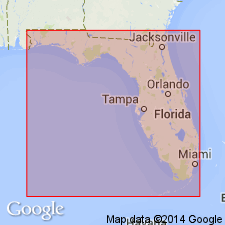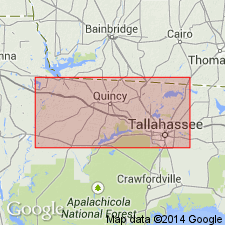
- Usage in publication:
-
- Fort Preston formation
- Modifications:
-
- Named
- Dominant lithology:
-
- Sand
- AAPG geologic province:
-
- South GA-North FL sedimentary province
Summary:
Name Fort Preston formation suggested for clastic sediments of middle Miocene age, as exposed at Alum Bluff and old Fort Preston. At type locality consists of basal conglomerate member, 1 ft thick, and upper 18.3-ft-thick member, consisting of argillaceous, calcareous, yellow, gray, and white variegated cross-bedded sand. Unconformably overlies Chipola Formation. Unconformably underlies Jackson Bluff formation (new).
Source: GNU records (USGS DDS-6; Reston GNULEX).

- Usage in publication:
-
- "Fort Preston sand"
- Modifications:
-
- Revised
- Biostratigraphic dating
- AAPG geologic province:
-
- Florida platform
Summary:
Informal "Fort Preston sand" here assigned to the top of the Alum Bluff Group. The unit may be reassigned later as an unconformity is recognized between the Fort Preston and the underlying Chipola. A small vertebrate fauna of late Hemingfordian or early Barstovian age has been recovered from the lower part of the unit. The lower Fort Preston then correlates in age with the Dogtown Member in the upper part of the Torreya Formation of the Hawthorn Group.
Source: GNU records (USGS DDS-6; Reston GNULEX).
For more information, please contact Nancy Stamm, Geologic Names Committee Secretary.
Asterisk (*) indicates published by U.S. Geological Survey authors.
"No current usage" (†) implies that a name has been abandoned or has fallen into disuse. Former usage and, if known, replacement name given in parentheses ( ).
Slash (/) indicates name conflicts with nomenclatural guidelines (CSN, 1933; ACSN, 1961, 1970; NACSN, 1983, 2005, 2021). May be explained within brackets ([ ]).

